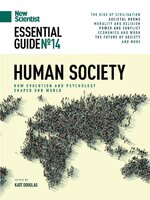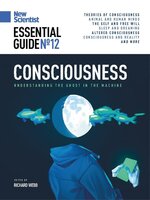The Essential Guide series brings together the best recent coverage from New Scientist specially curated into beautiful compendiums about the most exciting themes in science and technology today. Written and edited by some of the world’s best science writers, these guides will leave you with everything you need to know about subjects from nutrition to the solar system and more.
LIFE ON EARTH
New Scientist - The Essential Guides
HOW DID LIFE BEGIN?
THE CRADLE OF LIFE • The astounding innovation that was life must have arisen somewhere – somewhere that gave the right conditions for its rich chemistry to emerge and to be sustained. There are many contenders for the cradle of life, and arguments have long raged over which is the most promising.
DID LIFE COME FROM SPACE?
PROTEINS, GENES OR CELLS? • A central problem about the origin of life is that living organisms – even the most simple ones – are incredibly complex chemically. Most hypotheses about the first life assume that one or other of its essential components, proteins, genes and cells must have arisen first, with the others coming only later. But which?
LIFE’S POWER PACK • An alternative way to look for the origin of life comes from the idea that it must have begun with a series of chemical reactions that, through some mechanism, extracted energy from the environment and used it to build life’s molecules and structures. But when questions about the first life began to be asked, what powers today’s life was itself unclear.
OUT OF THE HYDROTHERMAL VENT • If proton power is the basic currency of life’s energy, the place where life first emerged must be one with plenty of energy to get those proton flows going. This idea suggested what remains one of the most popular hypotheses for where life first emerged.
DID EVERYTHING COME FIRST? • We have seen that scientists investigating the beginning of life have speculated that one or another of the components of living organisms predated all the others. But there may be another way to think about the problem: a kind of biological big bang.
NEW SCIENTIST ESSENTIAL GUIDES DELIVERED DIRECT TO YOUR DOOR
SINGLE - CELLED LIFE
ON THE ORIGIN OF MICROBES • When the first single-celled life forms evolved on Earth is a matter of intense controversy. It was early, that much is clear. Since then, members of the two great microbial “domains” – the bacteria and the archaea – have been busy evolving Earth, too.
A TIMELINE OF LIFE • The evolution of the first microbes perhaps as much as 3.9 billion years ago means Earth has harboured life for almost all of its history – but for most of that time only in simple forms
THE FIRST PHOTOSYNTHESISERS • Today, the air on planet Earth is rich in oxygen, which animals like us need to power our own metabolisms. But it wasn’t always so. Oxygen only accumulated because some microorganisms learned to harness the power of sunlight – perhaps the single most important development in the history of life.
VIRUSES: ANOTHER KIND OF LIFE • A further group of microscopic organisms has thrived on Earth since the early days: viruses. They are almost undoubtedly the most numerous and diverse living entities on Earth. Their mysteries start with whether they truly count as living.
WHERE DID VIRUSES COME FROM?
THE ORIGINS OF COMPLEX LIFE
THE FIRST COMPLEX CELLS • Besides bacteria and archaea, there is a third great domain of life: the eukaryotes, which includes all animals, plants and fungi. The individual cells of these organisms, including our own, have a diversified interior that allows for a far more intricate biochemistry. Complexity was a great innovation, but how these cells first appeared seems to have been an evolutionary accident.
WHEN DID EUKARYOTES EVOLVE? • The origin of eukaryotes is...

 EG25
EG25
 EG24
EG24
 EG23
EG23
 EG22
EG22
 EG21
EG21
 EG20
EG20
 EG19
EG19
 EG18
EG18
 EG17
EG17
 EG16
EG16
 EG15
EG15
 EG14
EG14
 EG13
EG13
 EG12
EG12
 EG11
EG11
 EG10
EG10
 EG09
EG09